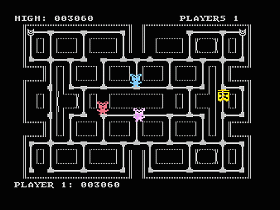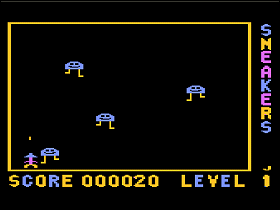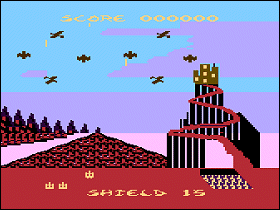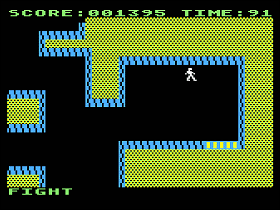Star Raiders
 The Game: Zylon warships are on the rampage, blasting allied basestars out of the sky and wreaking havoc throughout the galaxy. Your orders are to track down the fast-moving raiders and destroy them before they can do any more damage. You have limited shields and weapons at your disposal, and a battle computer which is vital to your mission (though critical damage to your space fighter can leave you without that rather important piece of equipment). The game is simple: destroy until you are destroyed, and defend friendly installations as long as you can. (Atari, 1979)
The Game: Zylon warships are on the rampage, blasting allied basestars out of the sky and wreaking havoc throughout the galaxy. Your orders are to track down the fast-moving raiders and destroy them before they can do any more damage. You have limited shields and weapons at your disposal, and a battle computer which is vital to your mission (though critical damage to your space fighter can leave you without that rather important piece of equipment). The game is simple: destroy until you are destroyed, and defend friendly installations as long as you can. (Atari, 1979)
Memories: The original version of Atari’s Star Raiders leaves very few doubts as to its origins; in a sense, it’s a new take on the old grid-based Star Trek mainframe game, only with ample opportunities for arcade-style action. Oh, and – astonishingly, even back then – the game kicks off with a title screen showing a spaceship obviously based on the Enterprise from Star Trek: The Motion Picture, which also appeared in 1979. How the lawyers missed that one, we’ll probably never know. [read more]

 The Game: The enemy in an interplanetary war has gone underground, and you’re piloting the ship that’s taking the fight to him. But he hasn’t just hidden away in a hole; he’s hidden away in a very well-defended hole. As if it wasn’t already going to be enough of a tight squeeze navigating subterranean caverns on Mars, you’re now sharing that space with enemy ships and any number of other fatal obstacles. (Fortunately, the enemy also leaves copious numbers of helpful fuel depots for you too.) Once you fight your way to the bottom of the cave, you plant charges on the enemy mothership – meaning that now you have to escape the caverns again, and fast. (Atari, 1981)
The Game: The enemy in an interplanetary war has gone underground, and you’re piloting the ship that’s taking the fight to him. But he hasn’t just hidden away in a hole; he’s hidden away in a very well-defended hole. As if it wasn’t already going to be enough of a tight squeeze navigating subterranean caverns on Mars, you’re now sharing that space with enemy ships and any number of other fatal obstacles. (Fortunately, the enemy also leaves copious numbers of helpful fuel depots for you too.) Once you fight your way to the bottom of the cave, you plant charges on the enemy mothership – meaning that now you have to escape the caverns again, and fast. (Atari, 1981) The Game: Plumber Larry Bain is out to earn his hazard pay, trying to run pipes through a rat-infested maze. This wouldn’t be a problem, except that the rats are as big as he is. He can lay a limited number of traps in the maze that will temporarily stop the rats in their tracks so he can double back and eliminate them, but in the end Larry’s best chance of survival is to stay on the run and fill the maze with plumbing. (Sierra On-Line, 1981)
The Game: Plumber Larry Bain is out to earn his hazard pay, trying to run pipes through a rat-infested maze. This wouldn’t be a problem, except that the rats are as big as he is. He can lay a limited number of traps in the maze that will temporarily stop the rats in their tracks so he can double back and eliminate them, but in the end Larry’s best chance of survival is to stay on the run and fill the maze with plumbing. (Sierra On-Line, 1981) The Game: Alien invaders are descending on your world, taking on unusual forms in the process: sneaker-clad stomping creatures, roaming eyeballs, “H-wing fighters,” flying saucers and more. Try to use their unusual patterns of movement against them and keep them from destroying your fighter. (Sirius Software, 1981)
The Game: Alien invaders are descending on your world, taking on unusual forms in the process: sneaker-clad stomping creatures, roaming eyeballs, “H-wing fighters,” flying saucers and more. Try to use their unusual patterns of movement against them and keep them from destroying your fighter. (Sirius Software, 1981) The Game: Hellish flying demons try to formation-dive your well-armed, devil-fryin’ vehicle at the bottom of the screen. Each time you knock one of this gargoylesque beasties out of the sky, they drop a piece of a bridge you must drag over to the appropriate spot on the screen. When you’re close to completing the bridge, the Prince of Darkness sends in some heavier artillery – a spooky floating demon head who spits fire at your cannon – to do away with you. Once you’ve toasted the flying meanies out of the sky and cross the bridge, it’s time to do battle with Satan himself. (CBS Video Games, 1982)
The Game: Hellish flying demons try to formation-dive your well-armed, devil-fryin’ vehicle at the bottom of the screen. Each time you knock one of this gargoylesque beasties out of the sky, they drop a piece of a bridge you must drag over to the appropriate spot on the screen. When you’re close to completing the bridge, the Prince of Darkness sends in some heavier artillery – a spooky floating demon head who spits fire at your cannon – to do away with you. Once you’ve toasted the flying meanies out of the sky and cross the bridge, it’s time to do battle with Satan himself. (CBS Video Games, 1982) The Game: The player controls a weary adventurer weaving his way through a dungeon populated by treasures and deadly danger. Starting out with the clothes on his back, a short sword in hand, and adding what he can along the way, the player’s adventurer progresses through twisty mazes, vanquishes an increasingly dangerous rogues’ gallery of foes, and tries to gather a wealth of treasure… but even opening those treasure chests may reveal traps. (Epyx, 1983)
The Game: The player controls a weary adventurer weaving his way through a dungeon populated by treasures and deadly danger. Starting out with the clothes on his back, a short sword in hand, and adding what he can along the way, the player’s adventurer progresses through twisty mazes, vanquishes an increasingly dangerous rogues’ gallery of foes, and tries to gather a wealth of treasure… but even opening those treasure chests may reveal traps. (Epyx, 1983) The Game: You’re the circuit maker, and they’re the circuit breakers. You hop around a maze-like structure, dropping circuitry patterns in your wake, as a variety of adversaries try to stop you from completing a circuit leading from the power source at your starting point to the receptacle across the maze from you. Colliding with any of them will cost you a life, but you can entice them to try to chase you off the maze and into oblivion while you escape safely. Completing the circuit advances you to the next maze – just on’t get too caught up in your power trip. (Tronix, 1983)
The Game: You’re the circuit maker, and they’re the circuit breakers. You hop around a maze-like structure, dropping circuitry patterns in your wake, as a variety of adversaries try to stop you from completing a circuit leading from the power source at your starting point to the receptacle across the maze from you. Colliding with any of them will cost you a life, but you can entice them to try to chase you off the maze and into oblivion while you escape safely. Completing the circuit advances you to the next maze – just on’t get too caught up in your power trip. (Tronix, 1983) The Game: Cavernous rooms are loaded with gold, just ripe for the picking. But before you celebrate hitting the mother lode, look again – there are other gold-diggers homing in on the treasure. What do you have that they don’t? A drill gun that can blast a hole in the floors, into which your opponents will jump blindly. Eventually, the holes will reseal themselves, and that process will swallow your enemies (and you, if you happen to be clumsy enough to wander into the hole yourself). Grabbing all of the gold will reveal a passage to the next level of the game. (Broderbund, 1983)
The Game: Cavernous rooms are loaded with gold, just ripe for the picking. But before you celebrate hitting the mother lode, look again – there are other gold-diggers homing in on the treasure. What do you have that they don’t? A drill gun that can blast a hole in the floors, into which your opponents will jump blindly. Eventually, the holes will reseal themselves, and that process will swallow your enemies (and you, if you happen to be clumsy enough to wander into the hole yourself). Grabbing all of the gold will reveal a passage to the next level of the game. (Broderbund, 1983) The Game: Pogo Joe has a pogo stick, a screen full of barrels whose colors need to be changed to the same target color, and a bunch of bouncy enemies too. Players guide Joe from barrel to barrel, sometimes requiring a big bounce if a barrel isn’t immediately adjacent to Joe’s current location, avoiding enemy creatures who are out to get him. Joe advances to the next level when the color of every barrel on the screen has been changed. A limited number of barrels per level act as a kind of “smart bomb” – landing on them wipes out all of Joe’s enemies temporarily (though they quitely repopulate the screen). (Screenplay, 1983)
The Game: Pogo Joe has a pogo stick, a screen full of barrels whose colors need to be changed to the same target color, and a bunch of bouncy enemies too. Players guide Joe from barrel to barrel, sometimes requiring a big bounce if a barrel isn’t immediately adjacent to Joe’s current location, avoiding enemy creatures who are out to get him. Joe advances to the next level when the color of every barrel on the screen has been changed. A limited number of barrels per level act as a kind of “smart bomb” – landing on them wipes out all of Joe’s enemies temporarily (though they quitely repopulate the screen). (Screenplay, 1983) The Game: Frogger’s back, and he needs your help to do so much more than just cross the road. First, help Frogger navigate an assortment of underwater dangers to reach the safety of a log at the water’s surface, and then help him hop across the backs of various animals and objects to cross the river. Once this is accomplished, you help Frogger ascend to heaven…and then the whole process starts once more. (Parker Brothers, 1984)
The Game: Frogger’s back, and he needs your help to do so much more than just cross the road. First, help Frogger navigate an assortment of underwater dangers to reach the safety of a log at the water’s surface, and then help him hop across the backs of various animals and objects to cross the river. Once this is accomplished, you help Frogger ascend to heaven…and then the whole process starts once more. (Parker Brothers, 1984)